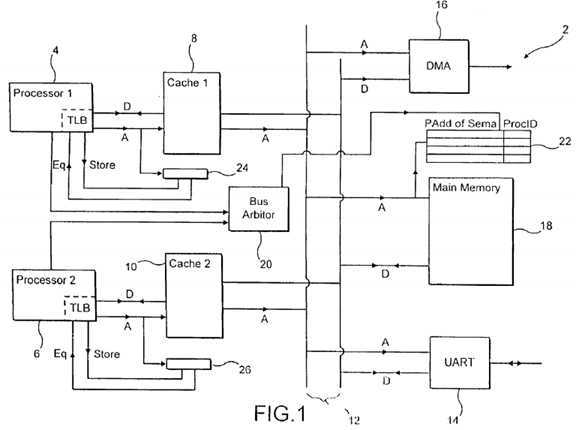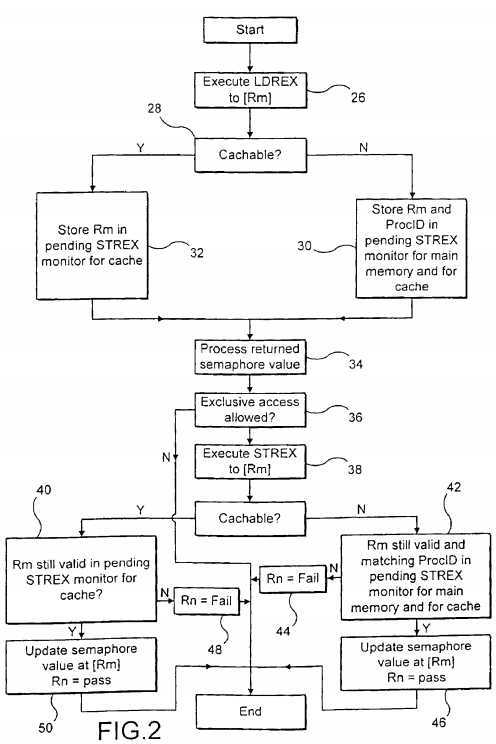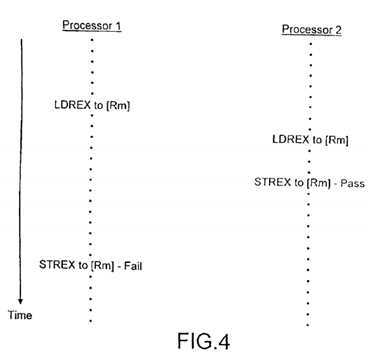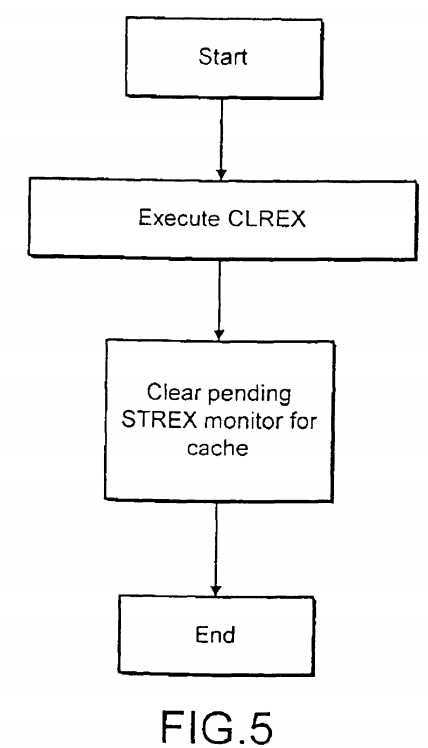标签:des style blog http color os strong io
A data processing system is provided with multiple processors that share a main memory. Semaphore values associated with data elements within the memory system, including the main memory, are used to establish exclusive access permissions to those data elements. An exclusive access clear instruction is provided that serves to clear any partially completed exclusive access requests for a processor between the reading of a semaphore value and the writing of a semaphore value to establish the exclusive access permission.
This invention relates to data processing systems. More particularly, this invention relates to data processing systems having control mechanisms for regulating exclusive access to processing resources.
It is known within data processing systems to provide processing resources, such as data elements within a database, that may be shared between different processors or processes. As an example, an airline reservation database system may have a central database storing information regarding the current booking status of an aircraft. This central database may be accessed from many different computers independently and may also be accessed by different processes running on a single computer. In order to ensure the integrity of the data concerned, exclusive access control mechanisms are used whereby exclusive access to a certain portion of the database is given to a particular processor or process at any one time to ensure that different copies of the same data do not come into existence causing data integrity problems.
It is known to use semaphore values associated with a processing resource to indicate whether exclusive access to that processing resource is available to an access requestor. More particularly, a read instruction may read a semaphore value for the purpose of determining whether or not exclusive access may be granted. If the semaphore value indicates that exclusive access would be available, then another instruction is executed to modify the semaphore value to indicate that exclusive access has been given to the access requestor.
Whilst such an arrangement can regulate the access to processing resources, real life systems also need to be able to accommodate such a mechanism within a system that may be subject to the occurrence of interrupts, exceptions or context switches, for example, that may intervene between a semaphore value being read to determine if exclusive access is available and the semaphore value being written to indicate that exclusive access has been allowed. The need to allow for such occurrences whilst not unduly impacting the latency of the system presents a technical problem.
Viewed from one aspect the present invention provides a method of processing data, said method comprising the steps of:
The invention provides an exclusive access clear instruction that serves to clear any semaphore identifying data that has been stored between retrieving a semaphore value and writing a new semaphore value such that a fresh start to establishing an exclusive access permission to a processing resource may later be forced to occur thereby avoiding problems due to intervening processing. As a particular example, should an interrupt, exception, or context switch occur, then an exclusive access clear instruction may be executed by the operating system so as to flush out any pending requests for exclusive access that have not yet been granted and properly locked in place thereby avoiding improper operation.
In order to accommodate multiple exclusive access requests from different sources, the step of writing a new semaphore value returns a result value indicative of whether or not that new semaphore value was written. The result value allows a determination to be made as to whether or not some other processor or process has been granted exclusive access to the processing resource before the step of writing for the current access requestor was able to establish the exclusive access for that access requestor.
The semaphore identifying data could be used in a variety of ways to control the establishing of exclusive access permissions, but a particularly efficient way of providing safe control is to arrange for the step of writing the new semaphore value to check the semaphore identifying data to determine whether or not it has been cleared between the step of storing and the step of writing.
In the case that an interrupt, exception, context switch or some other event had occurred between the storing and the subsequent write attempt, then an exclusive access clear instruction will have been executed to clear the semaphore identifying data and accordingly the write attempt will not succeed and an inappropriate exclusive access permission not granted. Avoiding an inappropriate write may also save bus resources within a system having a shared bus via which the write action must be performed, e.g. if the write action will use the main memory, which is typically on a shared bus, the stopping this write saves bus resources. Freeing the shared bus for use by other parts of the system increases the overall efficiency of the system.
It will be appreciated that the exclusive access requestors could be different processors within a multiprocessor system, or different tasks/processes within a multitasking/multiprocessing system.
The semaphore identifying data may be stored locally to the exclusive access requestor, local to the shared processing resource, or in both places. Storing the semaphore identifying data locally increases the speed with which this may be accessed and reduces the amount of resources that need to be provided to give non-local access to an exclusive access requestor.
It will be appreciated that the processing resource could take a variety of different forms. For example, the processing resource could be an input/output port. A high level memory device or the like. However, the invention is particularly useful in the control of exclusive access to data elements within a data memory.
Viewed from another aspect the invention provides an apparatus for processing data, said apparatus comprising:
The invention may also be embodied as a computer program product bearing a computer program for controlling a data processing apparatus in accordance with the above-described techniques.
The above, and other objects, features and advantages of this invention will be apparent from the following detailed description of illustrative embodiments which is to be read in connection with the accompanying drawings.
FIG. 1?schematically illustrates a data processing system?2?including a first processor?4?and a second processor?6. A first cache memory?8?is associated with the first processor?4?and a second cache memory?10?is associated with the second processor?6. A shared address and data bus?12?connects the first processor?4?and the second processor?6?with other system elements including a UART circuit?14, a DMA circuit?16?and a shared main memory?18. A bus arbiter?20?serves to ensure that only one bus master may have control of the shared bus?12?at any given time.

The main memory?18?stores data elements, such as for example database records, to which it is required to allow exclusive access by one of the first processor?4?and the second processor?6. Semaphore values are stored within the main memory18?for controlling the access to data elements, such as individual data records or areas of memory, for which exclusive access requests may be made. Monitoring circuitry?22?is provided local to the main memory?18?for storing data identifying which semaphore values have been retrieved by which processor?4?or?6. The semaphore identifying data takes the form of the physical memory address of the semaphore within the main memory together with processor identifying data, such as a processor number allocated by the bus arbiter?20. A semaphore identifying data store?24?is associated with the cache memory?8?and a further semaphore identifying data store?26?is associated with the cache memory?10. These semaphore data identifying stores?24,?26?are provided local to their respective processors?4,?6. When a retrieve operation is performed for a semaphore value within the main memory?18, the physical address of that semaphore value is stored within the respective local semaphore identifying data store?24,?26. Only a single pending exclusive access establishing operation is allowed to exist for each processor?4,?6?at any given time. The two processors?4,?6, may each have their own pending exclusive access establishing request, but the software programmers of the data processing system?2?are constrained not to rely upon more than one pending exclusive access requesting operation within a given processor?4,?6.
The processors?4,?6?may operate using virtual addresses, but a translation to physical addresses using a translation lookaside buffer (TLB) occurs within each processor?4,?6?before the memory addresses are output to the respective cache memories?8,?10?and the main memory?18. Thus, the semaphore identifying data relates to physical addresses rather than virtual addresses in this embodiment.
FIG. 2?is a flow diagram schematically illustrating the operation of the system of FIG.?1. At step?26, one of the processors?4,6?executes an LDREX instruction that loads a semaphore value from a memory location (specified within a register Rm) within the main memory?18. The LDREX instruction is different from a standard ARM LDR instruction that is used to load a memory value. The LDREX instruction utilises the mechanisms for establishing exclusive access relationships whereas the standard LDR instruction does not.

At step?28, a check is made as to whether or not the semaphore value being sought is cacheable. If the semaphore value is not cacheable, as indicated within an associated MMU (not illustrated), then processing proceeds to step?30. If the semaphore value is cacheable, then processing proceeds to step?32.
At step?30, the semaphore value corresponding to the address indicated by the Rm?register value is stored into a register Rdspecified within the LDREX instruction. Furthermore, the physical address of the semaphore value together with a processor identifying number for the processor executing the LDREX instruction is stored within the main memory monitor circuit?22. The bus arbiter?20?is triggered to provide this processor identifying number to the main memory monitor circuit?22?by the decoding of an LDREX instruction by one of the processors?4,?6. At step?30, the physical address of the semaphore data is also stored within the local semaphore identifying data store?24,?26?of the processor executing the LDREX instruction.
If processing from step?28?proceeds to step?32, instead of step?30, then no data is written into the main memory monitor circuit?22, but the physical address of the semaphore value being returned from address Rm?to register Rd?is written into the appropriate local semaphore identifying data store?24,?26.
At step?34, the semaphore value returned from the main memory?18?to one of the processors?4,?6?is examined to determine whether the retrieved semaphore value indicates that exclusive access to the associated data element is permitted. If exclusive access is not permitted, then processing terminates. Effectively, the exclusive access request attempt will be retried at some later time, possibly immediately using a tightly looped portion of code.
If the returned semaphore value indicates at step?36?that exclusive access is possible, then processing proceeds to step?38at which an STREX instruction is executed. The STREX instruction seeks to store a new semaphore value into the main memory?18?indicating the exclusive access permission that has been granted. The STREX differs from a standard ARM STR instruction in that an additional check on the pending semaphore identifying data is made and a result value is returned indicating whether or not the write was completed.
If the write was not completed, then this is indicative of another processor or process having established an exclusive access permission to the same data element in the intervening time between reading the semaphore value at step?26?and attempting to execute a corresponding STREX instruction at step?38.
If the physical memory address of the semaphore value indicates that the semaphore value is cacheable then processing proceeds to step?40. If the semaphore value is non-cacheable, then processing proceeds to step?42.
Step?42?checks within the local semaphore identifying data store?24,?26?and the main memory monitor circuit?22?that the physical address of the semaphore value that is being written to is still stored (i.e. has not been cleared or overwritten), and in the case of the main memory monitor circuit?22?that the matching processor number is associated with the physical memory address. The check is first made with the local store?24,?26. If this has been cleared, then a fail result is returned, otherwise the main memory monitor circuit?22?is examined and the result returned from there. If both these conditions are not met, then processing proceeds to step?44?at which a fail result value is returned from the STREX instruction, the write not having taken place and processing terminates. The exclusive access request attempt may in practice be retried.
If the tests of step?42?indicated that the semaphore identifying data stored both locally to the processor?4,?6?and within the main memory monitor circuit?22?still match (i.e. there has been no intervening exclusive access permission granted to another process, an intervening clear instruction or some other interference with the normal exclusive access permission granting process), then processing proceeds to step?46?at which the semaphore value within the main memory is updated to indicate the granting of the exclusive access permission to the originator of the STREX instruction and a pass result value returned.
If the test as to whether or not the new semaphore value of the STREX instruction was cacheable indicated that it was cacheable, then step?40?checks within the local semaphore identifying data store?24,?26?that the matching physical address is still present. If the matching physical address is not still present, then processing proceeds to step?48?at which a fail result value is returned. If the matching result is still present, then processing proceeds to step?50?at which the semaphore value within the main memory is updated and a pass result value returned.
FIG. 3?schematically illustrates an ARM object code routine for establishing an exclusive access permission. The LDREX instruction returns a semaphore value from the main memory?18?and sets up the appropriate semaphore identifying data. The CMP instruction determines whether or not the semaphore value indicates that exclusive access is possible. If exclusive access is not possible, then the BNE instruction returns processing to retry the request. If exclusive access is possible, then processing proceeds to further instructions, not illustrated, that set up the desired new semaphore value in register Rd. The instruction STREX serves to attempt to write the new semaphore value to the main memory?18. In accordance with the operation described in relation to?FIG. 2, the STREX instruction will only properly complete if the semaphore identifying data in the appropriate stores matches indicating that no inappropriate intervening action has occurred that would interfere with a proper exclusive access relationship being established. The CMP instruction following the STREX instruction examines the result value returned from the STREX instruction to determine whether or not the new semaphore value was properly stored and accordingly that the exclusive access relationship was established. The BNE instruction again attempts to retry the process if the result value indicated a fail.

FIG. 4?schematically illustrates two processors that are competing to establish an exclusive access relationship to the same data elements. Processor?1?issues its LDREX instruction to read the semaphore first. This indicates that an exclusive access permission is possible. However, before Processor?1?can issue its STREX instruction to confirm that exclusive access relationship, Processor?2?both reads and writes the same semaphore value to establish an exclusive access relationship for Processor?2. Accordingly, when the STREX instruction for Processor?1?is attempted, this returns a fail value indicating that the exclusive access permission is not possible even though the semaphore value read by Processor?1?had indicated that this was a possibility.

FIG. 5?schematically illustrates the operation of a CLREX instruction. This CLREX instruction is executed as an early step within any interrupt code or exception code as well as by context switching control software within a multitasking environment. The CLREX instruction serves to clear out any pending exclusive access permission requests that may be present for the processor executing the CLREX instruction. In practice, since the semaphore identifying data is stored within the local semaphore identifying data store?24,?26?of the processor?4,?6?irrespective of whether or not the semaphore value is cacheable, then clearing this local semaphore identifying data for the processor has the effect of stopping subsequent STREX instructions executing inappropriately for that semaphore value. In addition, providing this check, locally to the processor?4,?6?avoids the use of the shared system bus?12?thereby releasing this resource for use by other elements within the data processing system?2.

SRC=https://www.google.com.hk/patents/US6892257
Exclusive access control to a processing resource,布布扣,bubuko.com
Exclusive access control to a processing resource
标签:des style blog http color os strong io
原文地址:http://www.cnblogs.com/coryxie/p/3890813.html